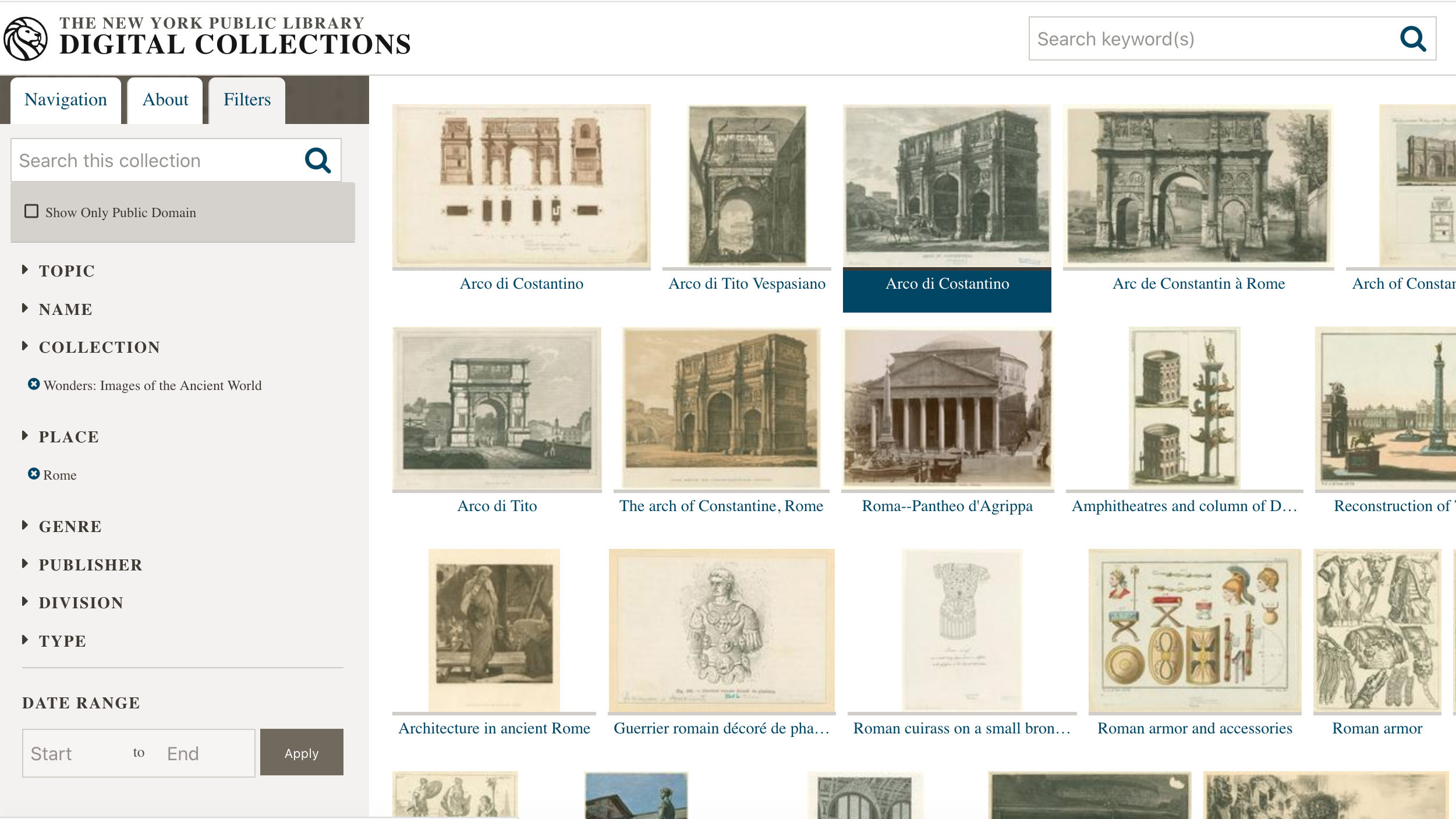
Screen capture of the New York Public Library database, Wonders: Images of the Ancient World
Overview
The Art Historical Image in the Digital Age at the American Academy in Rome is a five-day, intensive course designed to equip scholars of art from any historical period with the basic skill necessary to excel in the digital humanities: digital image management, organization, and analysis.
Since its inception, art history as a discipline has been based on the collection and reassemblage of images. Just as the ability to reproduce and circulate images through photography revolutionized the study of art in the nineteenth century, so too digital reproduction and online image banks have transformed the field in the twenty-first. The ease and speed with which digital images are now created, using a variety of apparatuses, from cell phones to high-tech digitization rigs, has meant that art historians have access to and create ever-growing numbers of images, from reproductions of artworks to scans of archival documents, books, and other primary sources. This profusion of digital images has transformed research practices in our field and raises several both practical and conceptual questions. How can individual scholars manage their own image data? What constitutes art historical “image data”? How can this data be classified, organized, and analyzed? In what ways can art historical research or publication practices leverage digital imaging tools and methods, while retaining the value of the material object?
This course takes advantage of the unique resources of the American Academy in Rome to prepare scholars to chart new directions in art history in the digital age. Using as a case study a set of art historical image data in Rome, a city Academy founder Charles F. McKim deemed the very best place to study art, the course will familiarize participants with the basics skills necessary to organize and manage digital images. Participants will learn the key concepts and vocabulary to discuss image data and its integral role in the digital humanities. They will also develop skills to manage image data most effectively for art historical research, such as the creation and manipulation of image metadata and digital tools like Mirador. As part of their investigation of digital images, participants will also discuss the impact of digital technology on our experience of art using Rome as an example.
The course is ideal for graduate students and scholars who are eager to develop new methodologies in art history using digital strategies. Participants will be selected on the basis of their ability to formulate compelling research questions about the conjunction of digital humanities and art history. While projects that address issues in art from antiquity to the modern era are welcome, preference will be given to those that would benefit from access to resources in Rome.
Dates
June 19–23, 2017.
Application Deadline
February 10, 2017.
Codirectors
Emily Pugh, Digital Humanities Specialist, Getty Research Institute; and Lindsay Harris, Andrew W. Mellon Professor, School of Classical Studies, American Academy in Rome.
Eligibility
The program is intended for graduate students and early career scholars in art history, but those who work in history or visual culture will also be considered. The program is open to candidates of all nationalities with a sufficient command of English.
Required Equipment
Participants are required to bring their own computers and hardware (cables, adaptors, etc.). All software used in the course will be open source and thus downloadable free of cost.
Costs
Tuition: 873.76 euro or $968
Housing is available at the American Academy for those who require it:
- Shared twin room (without bathroom) – € 225 for 6 nights
- Double room for single use (without bathroom) - € 450 for 6 nights
- Double room for single use (with bathroom) - € 600 for 6 nights
- Single Room (without bathroom) - € 385 for 6 nights
- Single room (with bathroom) - € 520 for 6 nights
Room availability cannot be guaranteed and applicants should indicate their need for housing in their application. Housing at the Academy is recommended as it makes participation easier and adds to the communal experience.
Meals: Meals can be purchased at the Academy (€15 for lunch and €27 for dinner). Meals may also be prepared in the AAR’s communal kitchens.
How to Apply
Please send your CV and a brief description of how this course will enhance your current art historical research (maximum 500 words) to: image-digital-age [at] aarome.org (image-digital-age[at]aarome[dot]org).
Deadline for tuition payments is May 1, 2017.
Accepted participants should send a check in dollars for the TUITION ONLY, made out to the American Academy in Rome, with an indication in memo line of "Art Historical Image" to:
American Academy in Rome
7 East 60th Street
New York, New York
10022-1001 USA
For those wishing to pay tuition in Euros you can:
- send a check in euros made out to the American Academy in Rome to the Rome address (Via Angelo Masina, 5 - 00153 Roma) to the attention of Francesco Cagnizzi
- make a bank transfer to the American Academy in Rome (please email for instructions)
- provide us with your credit card details by phoning +39 06 5846426
Once we have received all housing requests, accepted participants who have been granted housing at the Academy will be contacted by the institution to pay a housing deposit online via credit card.